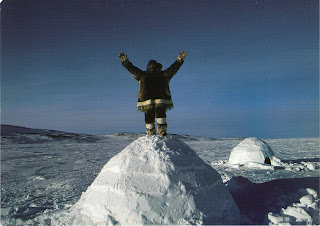The first time I saw an Igloo was at the Ottawa Winter Carnival back some time in the late sixties. The builders were Inuit but the material used was Styrofoam. A pre-cut set of blocks which linked together enabled people to see how these igloos were constructed.When I moved to the high Arctic I saw first hand how they could be made and used.I, myself learned the skill of building snow houses to great advantage. My friend Ikey showed me the rudiments of the skill.
The first thing is finding the right kind of snow. Inuit are able to walk over the snow and could tell if it was ok by the sound. A hollow sound indicates a snow somewhat the consistency of Styrofoam.Blocks are about 5-6 inches thick and vary in size to meet the proper fit. If you cut an orange in two and peel it from the cut side to the top you see the mode of required construction.
You need a snow knife, a handsaw will do and a cutting tool like a butcher knife for making small adjustments when the block is fitted to another. First pick a snow which is suitable. Mark the size you wish to build and cut blocks and place them outside the circle. Generally you have a third of the igloo built as you move all the snow out of the marked area.The first block is the most important as all others must fit and cause a ever higher level to the wall.The blocks are fitted with the help of the snow knife. Each block is cut to bring the wall upward and inward. You travel in a circle just as the peel of the orange. In no time your igloo is enclosing your space and the construction stops when only a small hole remains on top. This hole is shaped and a block is inserted to make a perfect enclosure. You then cut a small entrance hole for a doorway.
All the remaining snow inside the igloo is packed down and covered with hides of muskoxen or cariboo. The entrance is extended by building a small porch. Your belongings are brought inside and a primer stove provides heat to 30 degrees. I olden times and still used by some, a kullick is lit with wicks from Arctic Cotton and seal oil. Beds were made of snow and covered with hides for warmth.
Outside the dogs are placed on a line 6 feet apart and fed frozen fish. They will sleep under the snow and be comfortable.Today the dogs will not be present but a snow machine will take its place.A half igloo makes a good garage and I have built these to protect the white tents when camping out in winter.
The true test of a good igloo is to be able to stand on the top when completed. A 10 foot igloo, 7 feet high can be constructed in less than an hour. After the igloo is completed snow is thrown over the structure to give it that smooth look.

Outstanding! I will never need this skill, but how fun to know people survive under many circumstances.
ReplyDeleteCongratulations on your 100th post. What a wonderful accomplishment - especially in light of the fact that you just got going in June. What a milestone and excellent body of work!
ReplyDelete